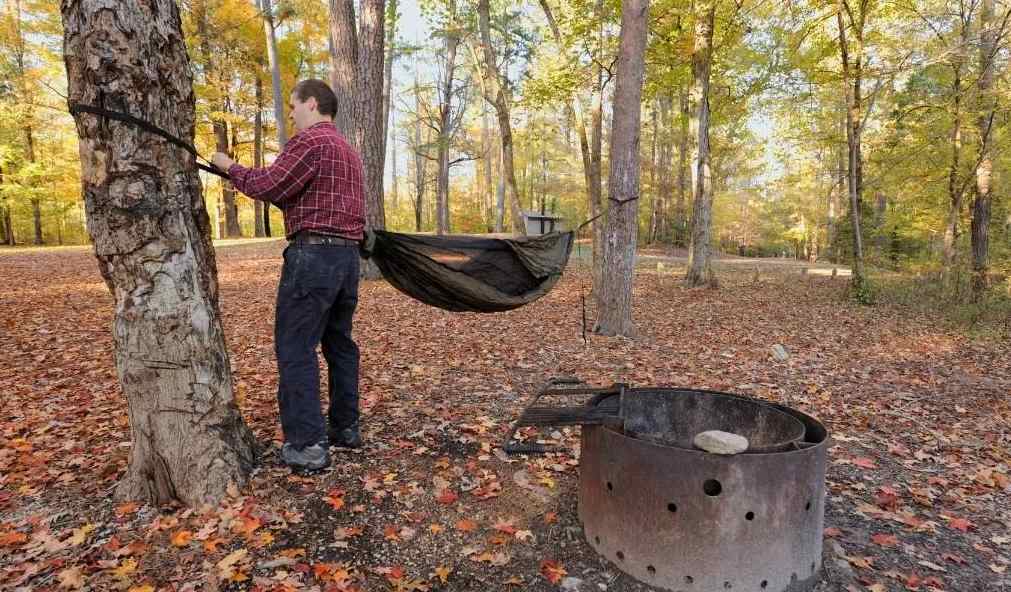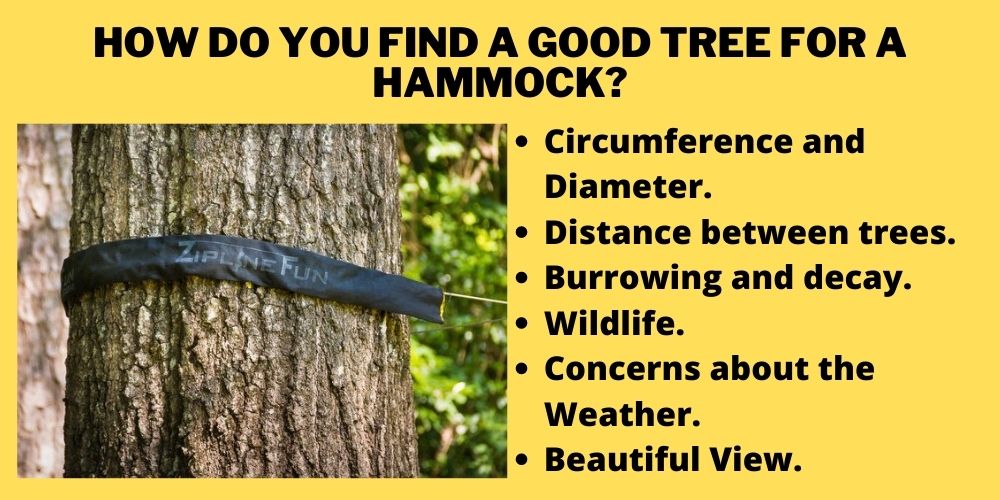When you consider hanging a hammock between two trees, the distance between trees plays an essential role. The supports must be sturdy enough to sustain the expected weight, and the spacing between both ends must be acceptable for the hammock.
But, exactly how far apart should trees be for a hammock?
Honestly, there is no perfect answer to how far apart trees should be for hanging a hammock because there is no single size for a hammock. However, calculating the hammock to be hanged is a simple technique to establish the distance.

Unroll it entirely, ensure it’s straight, and measure the length from edge to edge, including the rings used to hang it. Add 1 foot to this value to get the space between the required trees.
How far Apart Should Trees be for a Hammock?
The ideal spacing between trees for hammock hanging is 10 to 15 feet, and the minimum distance for spreader bar hammocks should be equal to the hammock’s length. However, hammocks lacking spreader bars can be strung anywhere that is both comfortable and secure.
When taking measurements between trees to hang your hammock, there are also a few things to consider. To begin, double-check if the trees are capable of sustaining your weight. You don’t want to wake up to an unpleasant crack preceded by a terrible smack on the ground in the night.
To sustain you for the long run, look for healthy, solid trees with a diameter of no less than 12 inches. After you’ve determined that you have robust choices for hanging your hammock, now the next step is to determine the distance between them. However, the appropriate distance will vary depending on your hammock model and intended use.
The minimum length between trees must be 2 feet greater than the hammock’s maximum length from loop to loop. It’s better to leave more room for the straps.
Keep in mind that if you’re hanging a tarp, the hanging distance must be more than the length of the tarp. There is a helpful table to illustrate the ideal distance between trees.
| Hammock Length | Hanging Distance |
| 9 ft | 12 ft to 14 ft |
| 10 ft | 13 ft to 15 ft |
| 11 ft | 14 ft to 15 ft |
| 12 ft | 15 ft to 17 ft |
Hanging Distance as per Hammock Types
Hammocks with Spreader Bars
A spreader bar hammock has stiff support at the feet and head ends, usually constructed of wood that helps maintain the linen spread out and straight. Because you wouldn’t want to take on the extra weight if you were traveling with a hammock, these are preferred for more permanent placements.
If you have a hammock with a spreader bar, the whole length of the hammock, including any cords or straps for support, should be the same as the distance between the trees.
As a result, a hammock that is 12 feet long will require 12 feet of space between trees. It’s best to leave a few additional feet between the trees if you want the hammock to be tenser. To extend the hanging points and achieve the ideal comfort for you, you may need to utilize more straps, rope, or chains.

Hammocks for Travel
The hanging distance is more flexible if your hammock does not have spreader bars. Because they’re typically lightweight and packable, these hammocks are more widely used.
For these hammocks, the distance between trees should be two-thirds the hammock’s length, together with any straps or rope further than cloth. As a result, if your hammock is ten feet long, the spacing between trees should be around six and a half feet. These hammocks are built with a “dip” in the middle, allowing them to hang freely.
Remember that the nearer the trees are to each other, the higher you’ll have to hang your hammock to avoid touching the ground. Alternatively, because the cloth may be extended horizontally, the further distant the trees are, the lower you can suspend your hammock from the ground.
While the two-thirds ratio is a decent starting point, the exact distance will determine how you intend to utilize the hammock.
How thick does a tree need to be for a hammock?
Ensure you choose your trees appropriately if you want to support a completely grown adult. A tree should have a diameter of at least 12 inches and be solid, healthy, and able to support your weight. It’s advisable to avoid a tree that has dead branches, or else you may injure yourself.
Because it depends on the type and strength of the tree, there is no minimum tree size for hanging a hammock; nevertheless, 6 inches is always a decent amount to aim for.
How do you know if a tree is strong enough for a hammock?
The most important consideration is if the tree is strong enough to sustain your weight. It’s not only whether it’ll tumble down; it’s also a question of whether it’ll move at all once you’re in your hammock. Opt for trees with a strong trunk and a diameter of at least six inches.

Even though the trunk is robust enough to support the hammock, the damage will occur if the tree above has unstable limbs that fall on the hammock user. Your properly hanging hammock could end up with a bad sag, or worse, on the floor if the tree sways.
How do you find a good tree for a hammock?
It’s critical to be cautious regarding which trees you use to hang your swings and hammocks. Give these trees at least twelve feet of space in front and back of the swing to ensure you have protected against any potential collisions. Ensure there are no bumps, massive exposed tree roots, or rocks in the way on top of the space.

Circumference and Diameter
The width of the trees, or their diameter, is also something to consider. Finding the correct size tree with a suitable diameter might be difficult. The most common issue is that the tree’s diameter is too great, causing your strap length to be consumed.
The best tree will have a diameter of 12 inches. Remember that the greater the tree trunk, the shorter the strap length will be. Keep in mind that to go around the complete circumference of a 12-inch diameter tree, you’ll need slightly over 3 feet of straps.
Distance between trees
Measure the distance between the two trees and their spacing. Based on the length of your hammock and the level of pressure you prefer, you’ll need a distance of at least 10 to 15 feet. This is an important consideration since it saves time when you can quickly locate a couple of trees that are the same length as your hammock and suspension cables.
If you’re unfamiliar with the term “suspension system,” it refers to the rope, strap, cord, or chain connecting the hammock to the anchor or the two places where you’ll hang your hammock.
It is highly recommended that the suspension be hung at a 30-degree angle to generate the proper force, and extreme suspension tightening increases the tension on both sides.
Burrowing and decay
Try to find decay or followings on the outside of the tree. Because it’s difficult to peek inside, look for fungus growing on weak bark, fallen branches, and stained leaves.
Wildlife
Keep an eye out for wildlife while you’re in the woods. Do not put your hammock in a tree where a bird’s nest has been discovered. Stay away from any areas where animals may be residing or resting.
Concerns about the Weather
If you’re going to a hammock camp in bad weather, choose trees that will offer you to hang your hammock parallel to the wind’s direction. As a result, the rain will not blow in on you, and your tarp will bear the brunt of the damage.
Beautiful View
You’re a camper that sleeps in a hammock. Most tent campers don’t have as many alternatives as you have. Make the most of it. If you have the time and daylight, take a trip around the area and look for trees that will provide you with a nice view.
Conclusion
It’s best to hang your hammock in a place that’s afoot (30 cm) or two longer than the hammock’s full length. The gear for hanging your hammock should be mounted five to six feet (1.5 m to 1.8 m) off the ground in such a location.
If the distance between the hanging points is short, try putting the screw-hooks higher, albeit the hammock will hang more bent. If the distance between the hanging locations is greater, you can raise the hardware and add an extra chain and S-hooks to hang the hammock normally.
Hopefully now you know how far apart should trees be for a hammock. If you find this article to be useful by any manner, then consider sharing it with your friends as well.


